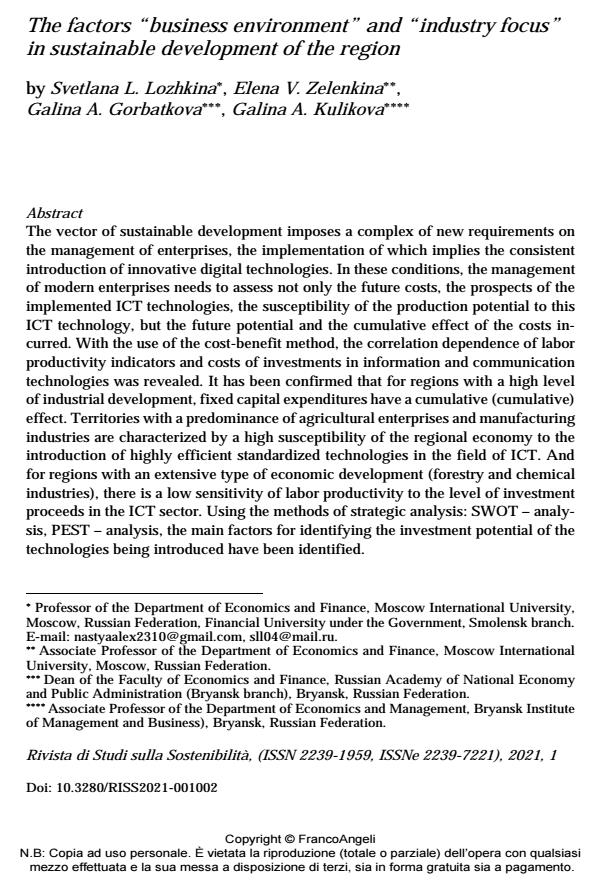The factors "business environment"and "industry focus" in sustainable development of the region
Titolo Rivista RIVISTA DI STUDI SULLA SOSTENIBILITA'
Autori/Curatori Svetlana L. Lozhkina, Elena V. Zelenkina, Galina A. Gorbatkova, Galina A. Kulikova
Anno di pubblicazione 2021 Fascicolo 2021/1
Lingua Inglese Numero pagine 18 P. 11-28 Dimensione file 173 KB
DOI 10.3280/RISS2021-001002
Il DOI è il codice a barre della proprietà intellettuale: per saperne di più
clicca qui
Qui sotto puoi vedere in anteprima la prima pagina di questo articolo.
Se questo articolo ti interessa, lo puoi acquistare (e scaricare in formato pdf) seguendo le facili indicazioni per acquistare il download credit. Acquista Download Credits per scaricare questo Articolo in formato PDF

FrancoAngeli è membro della Publishers International Linking Association, Inc (PILA)associazione indipendente e non profit per facilitare (attraverso i servizi tecnologici implementati da CrossRef.org) l’accesso degli studiosi ai contenuti digitali nelle pubblicazioni professionali e scientifiche
The vector of sustainable development imposes a complex of new requirements on the management of enterprises, the implementation of which implies the con-sistent introduction of innovative digital technologies. In these conditions, the management of modern enterprises needs to assess not only the future costs, the prospects of the implemented ICT technologies, the susceptibility of the produc-tion potential to this ICT technology, but the future potential and the cumulative effect of the costs incurred. With the use of the cost-benefit method, the correla-tion dependence of labor productivity indicators and costs of investments in in-formation and communication technologies was revealed. It has been confirmed that for regions with a high level of industrial development, fixed capital expendi-tures have a cumulative (cumulative) effect. Territories with a predominance of agricultural enterprises and manufacturing industries are characterized by a high susceptibility of the regional economy to the introduction of highly efficient standardized technologies in the field of ICT. And for regions with an extensive type of economic development (forestry and chemical industries), there is a low sensitivity of labor productivity to the level of investment proceeds in the ICT sec-tor. Using the methods of strategic analysis: SWOT - analysis, PEST - analysis, the main factors for identifying the investment potential of the technologies being introduced have been identified.
Parole chiave:information and communication technologies (ICT), factors, invest-ment attractiveness, region, industry focus.
- Barskov A. (2016). ICT for SMEs – A View from Southeast Asia. Computerworld Russia, 01(874): 26-27.
- Brother K. et al. (2009). Impact of ICT on the structural and contextual organizational elements: Case of the Varaždin County. J Info Org Sci, 33(2): 243-254.
- Cuevas-Vargas H. et al. (2016). The effect of ICTs as innovation facilitators for a greater business performance. Evidence from Mexico. Computer Science, 91: 54-58.
- Giotopoulos I. et al. (2017). What drives ICT adoption by SMEs? Evidence from a largescale survey in Greece. Journal of Business Research, 81: 64-67.
- Hiranya K.N., Lirong L. (2017). Information and communications technology (ICT) and services trade. Information Economics and Policy, 39: 7-16.
- IDC company (2020). ICT (global market). -- Retrieved from: http://www.tadviser.ru/index.php.
- Khuong M.V. (2013). Information and Communication Technology (ICT) and Singapore’s economic growth. Information Economics and Policy, 25: 292-296.
- Kumar R.R. et al. (2016). The effects of ICT on output per worker: A study of the Chinese economy. Telecommunications Policy, 40: 112-113.
- Lozhkina S.L. et al. (2020). Funding mechanisms for venture projects in the context of state stimulation and innovation development. Economic and human sciences, 1(333): 3-13.
- Pogodina T.V. et al. (2020). Formation of Russian companies with competitive advantages on the basis of innovations. Espacios, 41(17): 4. -- Retrieved from: http://www.revistaespacios.com/a20v41n17/20411704.html.
- Russian Statistical Yearbook 2019 (2019). Stat. book, Rosstat, М. 694 p.
- Tarute A., Gatautis R. (2014). ICT impact on SMEs performance. Social and Behavioral Sciences, 110: 1218-1225.
- Wang Y.Li. (2017). ICT’s effect on trade: Perspective of comparative advantage. Economics Letters, 155: 96-99.
- World Investment Report (2018). -- Retrieved from: https://unctad.org/en/PublicationsLibrary/wir2018_overview_ru.pdf.
- What business environment element configuration can promote urban digitization development? Hongxia Zhao, Hongyang Chen, Huijuan Zhao, Ying Lu, Jianhua Zhu, in Environment, Development and Sustainability /2023 pp.27923
DOI: 10.1007/s10668-023-03794-w
Svetlana L. Lozhkina, Elena V. Zelenkina, Galina A. Gorbatkova, Galina A. Kulikova, The factors "business environment"and "industry focus" in sustainable development of the region in "RIVISTA DI STUDI SULLA SOSTENIBILITA'" 1/2021, pp 11-28, DOI: 10.3280/RISS2021-001002